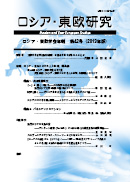Volume 2013, Issue 42
Displaying 1-14 of 14 articles from this issue
- |<
- <
- 1
- >
- >|
SPECIAL FEATURE: People, Lives, and Borders in Russia and Eastern Europe
-
2013Volume 2013Issue 42 Pages 2
Published: 2013
Released on J-STAGE: May 28, 2015
Download PDF (121K)
Special Feature Articles
-
2013Volume 2013Issue 42 Pages 3-16
Published: 2013
Released on J-STAGE: May 28, 2015
Download PDF (474K) -
2013Volume 2013Issue 42 Pages 17-31
Published: 2013
Released on J-STAGE: May 28, 2015
Download PDF (477K) -
2013Volume 2013Issue 42 Pages 32-44
Published: 2013
Released on J-STAGE: May 28, 2015
Download PDF (428K)
Panel Discussion
-
2013Volume 2013Issue 42 Pages 45-71
Published: 2013
Released on J-STAGE: May 28, 2015
Download PDF (985K)
REFEREED ARTICLES
-
2013Volume 2013Issue 42 Pages 72-87
Published: 2013
Released on J-STAGE: May 28, 2015
Download PDF (401K) -
2013Volume 2013Issue 42 Pages 88-102
Published: 2013
Released on J-STAGE: May 28, 2015
Download PDF (755K) -
2013Volume 2013Issue 42 Pages 103-120
Published: 2013
Released on J-STAGE: May 28, 2015
Download PDF (469K)
BOOK REVIEWS
-
2013Volume 2013Issue 42 Pages 121-124
Published: 2013
Released on J-STAGE: May 28, 2015
Download PDF (227K) -
2013Volume 2013Issue 42 Pages 125-127
Published: 2013
Released on J-STAGE: May 28, 2015
Download PDF (227K) -
2013Volume 2013Issue 42 Pages 128-130
Published: 2013
Released on J-STAGE: May 28, 2015
Download PDF (222K) -
2013Volume 2013Issue 42 Pages 131-133
Published: 2013
Released on J-STAGE: May 28, 2015
Download PDF (232K) -
2013Volume 2013Issue 42 Pages 134-139
Published: 2013
Released on J-STAGE: May 28, 2015
Download PDF (292K) -
2013Volume 2013Issue 42 Pages 140-144
Published: 2013
Released on J-STAGE: May 28, 2015
Download PDF (280K)
- |<
- <
- 1
- >
- >|
